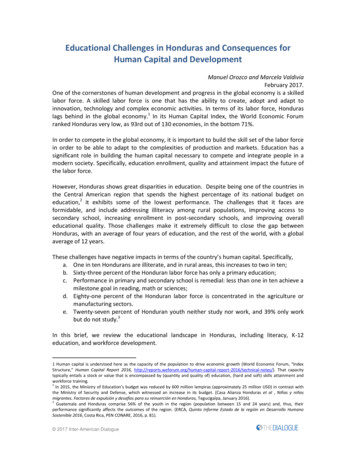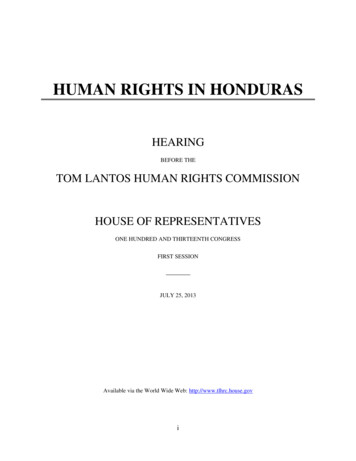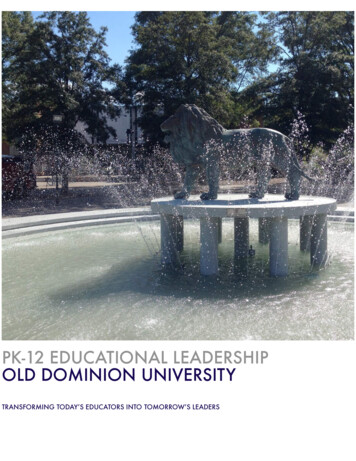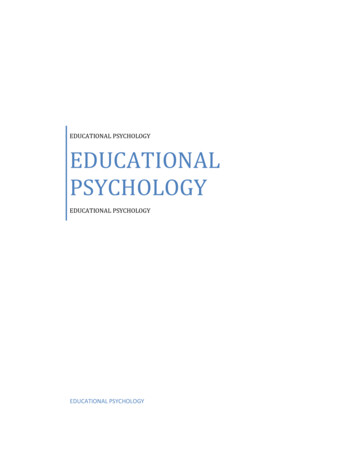
Transcription
Educational Challenges in Honduras and Consequences forHuman Capital and DevelopmentManuel Orozco and Marcela ValdiviaFebruary 2017.One of the cornerstones of human development and progress in the global economy is a skilledlabor force. A skilled labor force is one that has the ability to create, adopt and adapt toinnovation, technology and complex economic activities. In terms of its labor force, Honduraslags behind in the global economy.1 In its Human Capital Index, the World Economic Forumranked Honduras very low, as 93rd out of 130 economies, in the bottom 71%.In order to compete in the global economy, it is important to build the skill set of the labor forcein order to be able to adapt to the complexities of production and markets. Education has asignificant role in building the human capital necessary to compete and integrate people in amodern society. Specifically, education enrollment, quality and attainment impact the future ofthe labor force.However, Honduras shows great disparities in education. Despite being one of the countries inthe Central American region that spends the highest percentage of its national budget oneducation,2 it exhibits some of the lowest performance. The challenges that it faces areformidable, and include addressing illiteracy among rural populations, improving access tosecondary school, increasing enrollment in post-secondary schools, and improving overalleducational quality. Those challenges make it extremely difficult to close the gap betweenHonduras, with an average of four years of education, and the rest of the world, with a globalaverage of 12 years.These challenges have negative impacts in terms of the country’s human capital. Specifically,a. One in ten Hondurans are illiterate, and in rural areas, this increases to two in ten;b. Sixty-three percent of the Honduran labor force has only a primary education;c. Performance in primary and secondary school is remedial: less than one in ten achieve amilestone goal in reading, math or sciences;d. Eighty-one percent of the Honduran labor force is concentrated in the agriculture ormanufacturing sectors.e. Twenty-seven percent of Honduran youth neither study nor work, and 39% only workbut do not study.3In this brief, we review the educational landscape in Honduras, including literacy, K-12education, and workforce development.1 Human capital is understood here as the capacity of the population to drive economic growth (World Economic Forum, “IndexStructure,” Human Capital Report 2016, 16/technical-notes/). That capacitytypically entails a stock or value that is encompassed by (quantity and quality of) education, (hard and soft) skills attainment andworkforce training.2In 2015, the Ministry of Education’s budget was reduced by 600 million lempiras (approximately 25 million USD) in contrast withthe Ministry of Security and Defense, which witnessed an increase in its budget. (Casa Alianza Honduras et al , Niñas y niñosmigrantes. Factores de expulsión y desafíos para su reinserción en Honduras, Tegucigalpa, January 2016).3Guatemala and Honduras comprise 56% of the youth in the region (population between 15 and 24 years) and, thus, theirperformance significantly affects the outcomes of the region. (ERCA, Quinto Informe Estado de la región en Desarrollo HumanoSostenible 2016, Costa Rica, PEN CONARE, 2016, p. 81). 2017 Inter-American Dialogue
I.Educational Landscape: LiteracyHonduras has the third highest illiteracy rate in Central America, after Guatemala and ElSalvador. In 2015, 12% of the adult population (15 years and older) could not read or write,compared to 7% in the Latin America and Caribbean region as a whole.4 However, experts claimthat the number of people who are illiterate in Honduras is actually much higher than thesestatistics suggest.5Figure 1. Adult Literacy Rate, Population 25-64 years, both 015Latin America and the CaribbeanSource: UNESCO Institute for Statistics, “Adult Literacy Rate, Population 15 years, both sexes (%)”,available at: lliteracy rates are relatively high among male and female adults in Honduras. These rates arealso significantly higher among the elderly: among those 35 years and younger, illiteracy rate islower than 10%. However, this figure increases in the population 36 years and older and reachesits maximum among the population over sixty years of age, among which 30.2% are illiterate.Some of the greatest inequities emerge when comparing urban and rural populations, or highand low income groups, as the following tables show. The illiteracy rate among rural populationsis almost twice that of urban populations.6Figure 2. Literacy Rates by Sex and Urban/Rural SettingIlliteracy RateMenWomenTotal 8Source: Instituto Nacional de Estadística (INE), Encuesta Permanentede Hogares de Propósitos Múltiples (EPHPM), 2016.4This figure is actually a significant improvement. In 2001, only 78.4% of the adult population was literate (UNESCO Institute forStatistics, “Adult Literacy Rate, Population 15 years, both sexes (%)”, available at: nduras es el tercer país con tasa de analfabetismo más alta en Centroamérica”, HRN, May 4, 2016, available A1s-alta-encentroam%C3%A9rica645% of Hondurans live in rural areas according to the national census. 2017 Inter-American Dialogue
In general terms, when controlling for income, those among the highest income group (Q5)attended school for twice as long as a Honduran in the lowest income group. The disparityreflected in education is indicative of the economic inequality in Honduras, the highest in LatinAmerica.7Figure 3.Literacy Rates and Mean Years of Schooling by Sex and Income GroupTotalMenWomenIncomeMean yearsIlliteracyMean years ofIlliteracyMean yearsIlliteracy Rateof schoolingRateschoolingRateof schoolingGroupQuintile 120.05.720.15.520.05.8Quintile 216.36.516.56.216.26.7Quintile 39.47.49.17.29.67.5Quintile 47.28.56.58.47.88.6Quintile 52.511.12.711.12.411.1Source: INE, Encuesta Permanente de Hogares de Propósito Múltiples: Educación, 2016.Even more troubling is the fact that high levels of educational inequality have been present formost of the 21st century.Figure 4. Mean years of schooling by income group, 2009-20161210864202009201020112012Quintile 12013201420152016Quintile 5Source: INE, Encuesta Permanente de Hogares de Propósito Múltiples: Educación (2009-2016)Challenges to addressing illiteracy in Honduras include the lack of a comprehensive reform,scarce public resources devoted to the education system, high rates of grade repetition anddropouts, and the low educational attainment of parents.Primary EducationCoverageAlthough official statistics show that coverage is high, with 95% of Honduran children of schoolage enrolled in primary education, the teacher’s union claims that in 2015, a million childrenwere left out of the education system.87World Bank data shows that Gini coefficient for Honduras was 50.64 in 2014.Casa Alianza Honduras, Pastoral de Movilidad Humana and Catholic Relief Services, Niñas y niños migrantes. Factores de expulsióny desafíos para su reinserción en Honduras, Tegucigalpa, January 2016, p. 25.8 2017 Inter-American Dialogue
Figure 5. Adjusted Net Enrollment, Primary1009896949290882007200820092010Both Sexes (%)20112012Female (%)20132014Male (%)Source: UNESCO Institute for Statistics, “Adjusted net enrollment rate, both sexes, female and female, %”,available at: http://uis.unesco.org/Furthermore, drop-out rates9 among Honduran students at the primary level is significantlyhigher than in the Latin American region. In 2013, for example, a fourth of students dropped outcompared to 16% in the region.Among other causes, we can cite the necessity of increasing family earnings, forcing children outof school to begin working. The lack of a parent education is also another aspect related to dropout rates: in 2016, for example, 78% of the students who dropped out had parents with eitherno education or primary education only.10Figure 6. Cumulative drop-out rate to the last grade ofprimary education, both sexes 2013LACSource: UNESCO Institute for Statistics, “Cumulative drop-out rate to thelast grade of primary education, both sexes (%)”, available at:http://uis.unesco.org/9Cumulative drop-out rate to the last grade of primary education, both sexes (%): Proportion of pupils from a cohort enrolled in agiven grade at a given school year who are no longer enrolled in the following school year. Cumulative drop-out rate in primaryeducation is calculated by subtracting the survival rate from 100 at a given grade (Source: UNESCO Institute for Statistics).10See table in Annex. 2017 Inter-American Dialogue
Quality and PerformanceOfficial statistics show that approximately half of students in grades 1 to 9 reach satisfactory oradvanced performance in reading and only 35% reach these levels in mathematics.Figure 7. Percentage of students by level of attainment(grades ishUnsatisfactoryMathNeeds ImprovementSatisfactoryAdvancedSource: Ministry of Education, Informe Nacional de Rendimiento Académico 2015.But at the regional level, performance indicators are significantly lower. Honduran sixth gradersfare worse than their counterparts according to UNESCO’s annual examination (TERCE) of 15Latin American countries. The results of the test are summarized in Table 8. 11thFigure 8. Results of the 2015 TERCE Study by UNESCO (6 graders)HondurasRegional AverageHonduras ural Sciences66870012/15Writing2.873.1915/15Source: UNESCO, Tercer Estudio Regional Comparativo y Explicativo (TERCE): Informe de Resultados, July2015EquityAt the national level, students from urban areas fare better than those from rural areas, whilegender differences in performance tend to be more minimal.11TERCE, or the “Third Regional, Comparative and Explanatory Study” is conducted by UNESCO on a yearly basis. The study applies astandardized test to evaluate the performance of students at the primary education level in 15 countries of Latin America and onestate in Mexico (Nuevo León). 2017 Inter-American Dialogue
Figure 9. Performance of Sixth Graders by RuralUrbanSpanishInsatisfactoryMathNeeds ImprovementSatisfactoryAdvancedSource: Ministry of Education, Informe Nacional de Rendimiento Académico 2015.Figure 10. Performance of Sixth Graders by 1BoysGirlsSpanishInsatisfactoryNeeds ImprovementMathSatisfactoryAdvancedSource: Ministry of Education, Informe Nacional de Rendimiento Académico 2015.Going Backwards in Secondary EducationThe challenge of primary education does not compare at all with the daunting problems insecondary schooling in Honduras. 12 To give some perspective, of the 23,835 schools, 21,761 arepublic schools, but only 10% or less offer secondary education.13 Moreover, close to 80% ofthose schools are in urban areas.1412Secondary education is comprised of a lower secondary cycle, grades 7-9, which is part of mandatory basic education, and anupper secondary cycle, grades 10 and 11 in the academic stream and 10-12 in the vocational stream.13There are 2,161 schools that offer “educación media” in Honduras (See Secretaría de Educación, Sistema Educativo Hondureño enCifras –Periodo Académico 2015, June 2016, p. 19, available RME ESTADISTICO 2014 Y 2015.pdf ).14Ibid., p. 14. 2017 Inter-American Dialogue
Secondary education in Honduras is of critical importance: according to the World Bank, privaterates of return to schooling are highest at the upper secondary level, even higher than returnsto university schooling.15One consequence is that the number of students enrolled at the secondary level includes only48% of youth of secondary-school age. Moreover, this number drops to 25% at the uppersecondary level.16 In other words, only one in four youth age 16 to 18 is enrolled in uppersecondary school. In practical terms, less than 500,000 kids in that age group are enrolled insecondary school in a country of more than 7 million people.Another factor that accounts for the low enrollment rates at this level is criminal violence. Arecent study observes that Honduran youth, ages 13-17, are the most targeted age group bycriminal groups to engage them in activities such as extortion and drug trafficking amongothers.17Statistically, we find that homicide rates not only correlate with migration but with schoolenrollment.Figure 11. School Enrollment and Homicides in Honduras, e: Inter-American Dialogue, Database on violence, education andmigration, 2016.15Ilana Umansky, Russbel Hernandez, Mario Alas and German Moncada, Alternative Upper Secondary Education in Honduras:Assessment and Recommendations”, USAID-Honduras, February 2007, available at: http://pdf.usaid.gov/pdf docs/Pnadr154.pdf16UNESCO Institute for Statistics, Secondary Education: Adjusted Net Enrollment Rate, Lower Secondary and Upper Secondary, BothSexes (%), accessed through the World DataBank, available ?source Education%20Statistics&preview off17Casa Alianza Honduras, Pastoral de Movilidad Human and Catholic Relief Services, Niñas y niños migrantes. Factores de expulsión ydesafíos para su reinserción en Honduras, January 2016. 2017 Inter-American Dialogue
Performance and EquityThe problems at the secondary level get worse because among those who enroll, more than halfof students fall in the category “in need of improvement” in the areas of Mathematics andSpanish. Not one student tested in Math has achieved an ‘advanced’ level. Although girls havea higher enrollment rate, and lower dropout rate, at both lower secondary and upper secondarylevels, they fare equally low in all levels of education when it comes to performance.Figure 12. Performance of Students in Lower Secondary (Gr. satisfactoryMathNeeds ImprovementSatisfactoryAdvancedSource: Ministry of Education, Informe Nacional de Rendimiento Académico 2015.Figure 13. Performance of Students in Lower Secondary by isfactoryNeeds edSource: Ministry of Education, Informe Nacional de Rendimiento Académico 2015. 2017 Inter-American Dialogue
Figure 14.Adjusted Net Enrollment Rate (2014)Lower SecondaryUpper SecondaryFemale (%)52.129.1Male (%)44.921.1Both Sexes (%)48.425Source: Unesco Statistics Secondary Education: Adjusted NetEnrollment Rate, Lower Secondary and Upper Secondary, BothSexes (%), accessed through the World DataBank.Higher EducationWhen it comes to higher education, Honduras’ 20 institutions of higher education, six of whichare public, recruit those who finish secondary education. However, as school graduationapproaches, the education system resembles a funnel, from low completion in primary to lowenrollment in secondary and finally, with only 21% of Hondurans (in the five-year age groupfollowing on from secondary school) enrolling in a higher education institution. This amountedto 187,000 students in 2013.18 Of those, 61.5% of all students enrolled were at publicinstitutions19 (See Appendix). The majority of these students enroll in liberal arts careers andeducation, and 20% in sciences.20 With a 10.9% graduation rate,21 Honduras is graduating lessthan 20,000 people in the sciences every year.Figure 15. Gross Enrollment Ratio, Tertiary 014Both SexesSource: UNESCO Statistics, Tertiary: Gross Enrollment Ratio (Female, Male and Both Sexes), 2012-2014,accessed through World DataBank, available ?source Education%20Statistics&preview off18World Bank, Education Statistics, The World Bank database. Accessed 2017.Dirección de Educación Superior, Statistics: “Percentage of Coverage by Administration (Higher Education), 2010-2015”, availableat: sticas/20Ibid., “Enrollment in Institutions of Higher Education by Field of Study, available at: ticas/21UNESCO Institute for Statistics, Tertiary: Gross graduation ratio from first degree programmes (ISCED 6 and 7) in tertiaryeducation, both sexes (%), accessed through World DataBank, available ?source Education%20Statistics&preview off19 2017 Inter-American Dialogue
Figure 16. Enrollment in Tertiary Education Institutions by Field of Study1%Education14%3%20%Humanities and ArtSocial Sciences, Trade and Law3%Sciences13%Engineering and construction industryAgriculture6%40%Health and Social ServicesServicesSource: Dirección de Estudios Superiores, “Enrollment in Tertiary Education Institutions by Field of Study,UNESCO 2015”, available at: sticas/II.Education, Human Capital and DevelopmentIn addition to being a core element in human capital, the educational landscape forms a basisfor the composition of the country’s labor force. For one, as the young population enters thefunnel of education, they enter the labor force with weak training, both in level and quality ofeducation attained. In turn, adults participate in the labor market with limited knowledge andskills.Therefore, the labor force lacks the skills needed to access high-quality jobs and reduceinequality. Moreover, with few science and technology degrees, the labor force is unfit tocompete in the global economy and promote innovation.Unskilled Labor ForceAs seen earlier, net enrollment rates at different stages of education decrease progressively. Theeffect of this ‘educational funnel’ is that the stock of Honduras’ human capital is highlyconcentrated in the primary education sector or below, which is also reflected in thecomposition of its labor force.In 2013, only 7% of the Honduran labor force had more than 12 years of schooling, the averageperiod of education that reduces the risk of being poor, according to Economic Commission forLatin America and the Caribbean.2222Cited in Programa Estado de la Nación en Desarrollo Humano Sostenible (Costa Rica), Quinto Informe Estado de la Región/PENCONARE, San José, PEN, 2016. 2017 Inter-American Dialogue
Figure 17. Educational attainment of labor force (as % of total), 20137%Primary Education30%Secondary EducationTertiary Education63%Source: UNESCO Statistics, Educational Attainment, Labor force with primary, secondary and tertiaryeducation (% of total).One consequence, or byproduct of this model of growth, is that 81% of the labor force isconcentrated in the agriculture and industry sectors (comprised of manufacturing, mining andconstruction, among others).23 Moreover, those working in services predominantly operatewithin the informal economy.Figure 18. Labor Force Distribution by eSource: International Labor Organization (ILO), Social Protection & Labor: Economic Activity: Employmentin Services, Industry and Agriculture (as % of total employment), accessed through World Databank.23The industry sector, as defined by the International Labor Organization, consists of mining and quarrying, manufacturing,construction, and public utilities (electricity, gas, and water). 2017 Inter-American Dialogue
Although enrollment rates are higher for females at all levels of education, the presence ofwomen falls dramatically once it comes to the composition of the labor force. In 2011, only 40%of women (ages 15 and older) were employed compared to 57% of men. The gender disparityreflects a deep rooted bias in the society, pointing woman to a subordinate position as childbearers and homemakers.As economic necessity related to inequality pushes youth to drop out school, males, as‘providers’ tend to enroll the labor force in larger numbers, while expecting girls and women tostay home. Thus, enrollment ratios in school, K-12, is higher because of this bias. When it comesto enrolling in the labor force, the challenge to integrate females into the labor force turns in toone of numbers, quality, training and empowerment.Figure 19. Employment to Population Ratio, 15 (%) (National 07Male2008Female200920102011TotalSource: International Labor Organization, Social Protection & Labor: Economic Activity: Employment topopulation ratio, 15 , female, male and total (national estimates), accessed through World Databank.Low Innovation, Low WagesAmong the many consequences of poor educational attainment and performance are lowearnings, low skills and informal activity. Fifty-three percent of Honduras are unskilled workersearning less than the minimum wage. In the informal sector, two thirds of workers earned lessthan the minimum wage. Close to half of the agricultural workers and unskilled workers were inthe same situation. 2017 Inter-American Dialogue
Figure 20. Share of workers in each sector earning less than and at theminimum wage, 2013Less than 90% ofWithin /-10% ofminimum wageMinimum WageWorkers64.712.3Urban wage .14.0Urban32.110.2Source: Working to End Poverty in Latin America and the Caribbean: Workers,Jobs and Wages, World Bank, 2015.Another consequence of poor education, particularly within the context of a society plagued bylarge challenges in personal safety and insecurity, is migration.One of the most important effects of migratory processes can be seen in the educationallandscape. For example, in 2014, for example, more than 60,000 children dropped out, 17% ofwhich did so because they migrated (either domestically or internationally). See table below.Figure 21. Drop-out Students by Category, 2014-2015Category of Desertion2014%2015%Student dropped out49,9728141,16787.8Student died1910.31480.3Student migrated to other country10,487173,2937.0Student migrated within ce: Ministry of Education, Informe Nacional de Rendimiento Académico 2015. 2017 Inter-American Dialogue
ConclusionsEducation remains a critical tool to build human capital and endow a country’s workforce withthe necessary skills to compete in a globalized economy. As this brief has shown, Honduras facessignificant challenges in its educational landscape and poor performance at the earliest levelsbecomes, in practice, obstacles for achievement at higher levels. As a result, more than half ofHonduras’ workforce has a primary education only which, in turn, affects their income andpoverty levels.Similarly to other countries in the region, development, insecurity and education are closelyinterrelated in Honduras. On the one hand, its pervasive violence constitutes a significant factorthat hinders educational enrollment and performance among the students. On the other,migration processes that result from lack of opportunities and violence also exert an influenceon the number of drop-out students across the whole education specter.Furthermore, despite its relative high levels of investment in education, Honduras fares lowerthan its regional counterparts and students exhibit significant differences in their performanceaccording to their income level.What comes across is the need to rethink the prevailing approach to education and humancapital in Honduras, motivating a national dialogue that goes beyond simply educationalexpenditures, and considers the role of investments in extracurricular and after schooleducation. Under the existing circumstances, it is highly unlikely that the economy and its laborforce will substantially progress beyond limited goals; education reform requires a radicaldeparture from the current approach. 2017 Inter-American Dialogue
AppendixFigure A. Drop-out rate in relation to the educational attainmentof students’ parents% of students who droppedEducational attainment of parentout from previous yearNo es not know/Does not respond0.3Source: INE, Encuesta Permanente de Hogares de Propósito Múltiples: Educación (2009-2016)Figure B. Percentage of Coverage by Type of cPrivate20142015Source: Dirección de Estudios Superiores, “Porcentaje de CObertura de Educación Superior según tipo deadministración, 2010-2015”, available at: sticas/11Figure C. Gross Graduation Ratio from First DegreePrograms in Tertiary 2Source: UNESCO Institute for Statistics, “Gross Graduation Ratio from First Degree Programs in TertiaryEducation”, accessed through World DataBank. 2017 Inter-American Dialogue
secondary schooling in Honduras.12 To give some perspective, of the 23,835 schools, 21,761 are public schools, but only 10% or less offer secondary education.13 Moreover, close to 80% of those schools are in urban areas.14 12 Secondary education is comprised of a lower secondary cycle, grades 7-9, which is part of mandatory basic education, and an










